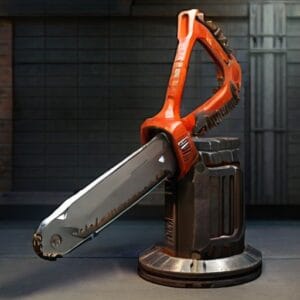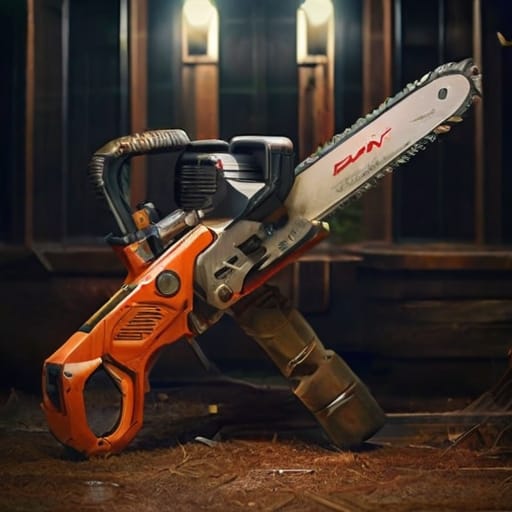Introduction
If you’re looking for a reliable chainsaw for various tree-cutting tasks, you should definitely consider a bow bar chainsaw. The unique design of bow bar chainsaws makes them ideal for cutting branches, brush, and small trees. In this article, we’ll take a closer look at the features and advantages of bow bar chainsaws. Get ready to dive into the world of this exceptional tool; we promise it will keep you intrigued!

What is a Bow Bar Chainsaw?
A bow bar chainsaw is a type of chainsaw that features a curved guide bar. This curved bar is especially suitable for cutting small fence posts or pulpwood-sized trees. It was widely used by the US Forest Service Hotshot fire fighting crews in the 1980s because it was extremely effective for this purpose. The smaller the diameter of the bow bar, the better it is for brush cutting.
How Does a Bow Bar Chainsaw Work?
Like other chainsaws, a bow bar chainsaw is designed to cut tree limbs with its sharp teeth rotating around the guide bar. However, the difference lies in the curved bar, which allows for more precise cuts and better control. This makes it ideal for cutting branches close to the trunk of a tree or for cutting trees that have already been felled.
What are the Advantages of a Bow Bar Chainsaw?
One of the main advantages of a bow bar chainsaw is its versatility. Its curved guide bar allows it to handle a variety of tree-cutting tasks, from trimming branches to cutting small trees. Additionally, it is easier to control than other types of chainsaws, which makes it safer to use. The bow bar chainsaw is also more efficient than other types of chainsaws when it comes to cutting brush and small trees.
From My Own Experience
As a carpenter, I have personally experienced many benefits of working with bow bar chainsaws. Especially when you need to make precise cuts in tight spaces, the control and accuracy provided by this chainsaw are truly impressive. Moreover, it saves a lot of time when clearing brush or quickly cutting small trees. Whether in my workshop or out in the field, the reliability and versatility of the bow bar chainsaw have always satisfied me.

Disadvantages of a Bow Bar Chainsaw
While the bow bar chainsaw is indeed a versatile tool, it does come with a few drawbacks. One of the primary disadvantages is its limited effectiveness on larger trees. The curvature of the bar restricts the length of the guide bar, thereby limiting the depth of the cut. This makes it less suitable for cutting larger trees compared to other types of chainsaws. Additionally, bow bar chainsaws are not as widely available, which can pose challenges in finding replacement parts or getting the saw serviced.
How to Choose the Right Bow Bar Chainsaw
When selecting a bow bar chainsaw, several factors should be taken into account. Firstly, consider the specific cutting tasks you plan to undertake. For cutting mostly small trees and brush, a smaller diameter bow bar will be more effective. On the other hand, if your tasks involve larger trees, opting for a larger diameter bow bar will be necessary.
Another important consideration is the weight of the chainsaw. Heavier chainsaws can be more challenging to control, so it’s essential to choose one that you can handle comfortably. Lastly, pay attention to the brand and model of the chainsaw. Some brands are renowned for their quality and durability, which can be crucial for long-term use and reliability.
My Professional Insight
From my experience as a carpenter, the choice of the right bow bar chainsaw can significantly impact your efficiency and ease of work. When working on precision cuts in confined spaces, the control offered by a well-chosen bow bar chainsaw is invaluable. However, understanding its limitations is equally important to ensure it meets your specific needs. Balancing the chainsaw’s weight, bar diameter, and brand reliability can make all the difference in achieving optimal performance and safety in your projects.
Disadvantages of a Bow Bar Chainsaw
While the bow bar chainsaw is indeed a versatile tool, it does come with a few drawbacks. One of the primary disadvantages is its limited effectiveness on larger trees. The curvature of the bar restricts the length of the guide bar, thereby limiting the depth of the cut. This makes it less suitable for cutting larger trees compared to other types of chainsaws. Additionally, bow bar chainsaws are not as widely available, which can pose challenges in finding replacement parts or getting the saw serviced.
How to Choose the Right Bow Bar Chainsaw
When selecting a bow bar chainsaw, several factors should be taken into account. Firstly, consider the specific cutting tasks you plan to undertake. For cutting mostly small trees and brush, a smaller diameter bow bar will be more effective. On the other hand, if your tasks involve larger trees, opting for a larger diameter bow bar will be necessary.
Another important consideration is the weight of the chainsaw. Heavier chainsaws can be more challenging to control, so it’s essential to choose one that you can handle comfortably. Lastly, pay attention to the brand and model of the chainsaw. Some brands are renowned for their quality and durability, which can be crucial for long-term use and reliability.
My Professional Insight
From my experience as a carpenter, the choice of the right bow bar chainsaw can significantly impact your efficiency and ease of work. When working on precision cuts in confined spaces, the control offered by a well-chosen bow bar chainsaw is invaluable. However, understanding its limitations is equally important to ensure it meets your specific needs. Balancing the chainsaw’s weight, bar diameter, and brand reliability can make all the difference in achieving optimal performance and safety in your projects.
